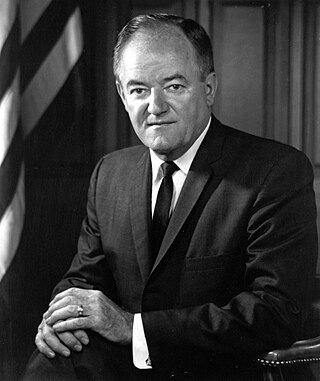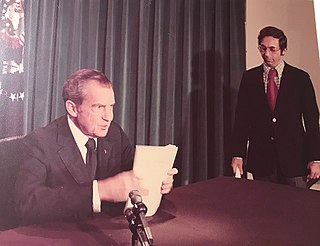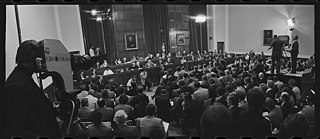
Henry Alfred Kissinger was an American diplomat, political scientist, geopolitical consultant, and politician who served as the United States secretary of state and national security advisor in the presidential administrations of Richard Nixon and Gerald Ford between 1969 and 1977.

Richard Milhous Nixon was the 37th president of the United States, serving from 1969 to 1974. A member of the Republican Party, he previously served as a representative and senator from California and as the 36th vice president from 1953 to 1961 under President Dwight D. Eisenhower. His presidency saw the reduction of U.S. involvement in the Vietnam War, détente with the Soviet Union and China, the Apollo 11 Moon landing, and the establishment of the Environmental Protection Agency and Occupational Safety and Health Administration. Nixon's second term ended early when he became the only U.S. president to resign from office, as a result of the Watergate scandal.

Hubert Horatio Humphrey Jr. was an American politician and statesman who served as the 38th vice president of the United States from 1965 to 1969. He twice served in the United States Senate, representing Minnesota from 1949 to 1964 and 1971 to 1978. As a senator he was a major leader of modern liberalism in the United States. As President Lyndon B. Johnson's vice president, he supported the controversial Vietnam War. An intensely divided Democratic Party nominated him in the 1968 presidential election, which he lost to Republican nominee Richard Nixon.

The Watergate scandal was a major political scandal in the United States involving the administration of President Richard Nixon from 1972 to 1974 that led to Nixon's resignation. The scandal stemmed from the Nixon administration's attempts to cover up its involvement in the June 17, 1972, break-in of the Democratic National Committee headquarters in Washington, D.C., at the Watergate Office Building.

Melvin Robert Laird Jr. was an American politician, writer and statesman. He was a U.S. congressman from Wisconsin from 1953 to 1969 before serving as Secretary of Defense from 1969 to 1973 under President Richard Nixon. Laird was instrumental in forming the administration's policy of withdrawing U.S. soldiers from the Vietnam War; he coined the expression "Vietnamization," referring to the process of transferring more responsibility for combat to the South Vietnamese forces. First elected in 1952, Laird was the last living Representative elected to the 83rd Congress at the time of his death.
The silent majority is an unspecified large group of people in a country or group who do not express their opinions publicly. The term was popularized by U.S. President Richard Nixon in a televised address on November 3, 1969, in which he said, "And so tonight—to you, the great silent majority of my fellow Americans—I ask for your support." In this usage it referred to those Americans who did not join in the large demonstrations against the Vietnam War at the time, who did not join in the counterculture, and who did not participate in public discourse. Nixon, along with many others, saw this group of Middle Americans as being overshadowed in the media by the more vocal minority.
The Nixon Doctrine was put forth during a press conference in Guam on July 25, 1969, by President of the United States Richard Nixon and later formalized in his speech on Vietnamization of the Vietnam War on November 3, 1969. According to Gregg Brazinsky, author of "Nation Building in South Korea: Koreans, Americans, and the Making of a Democracy", Nixon stated that "the United States would assist in the defense and developments of allies and friends", but would not "undertake all the defense of the free nations of the world." This doctrine meant that each ally nation was in charge of its own security in general, but the United States would act as a nuclear umbrella when requested. The Doctrine argued for the pursuit of peace through a partnership with American allies.

The history of the United States from 1964 through 1980 includes the climax and end of the Civil Rights Movement; the escalation and ending of the Vietnam War; the drama of a generational revolt with its sexual freedoms and use of drugs; and the continuation of the Cold War, with its Space Race to put a man on the Moon. The economy was prosperous and expanding until the recession of 1969–70, then faltered under new foreign competition and the 1973 oil crisis. American society was polarized by the ultimately futile war and by antiwar and antidraft protests, as well as by the shocking Watergate affair, which revealed corruption and gross misconduct at the highest level of government. By 1980 and the seizure of the American Embassy in Iran, including a failed rescue attempt by U.S. armed forces, there was a growing sense of national malaise.
A United States presidential doctrine comprises the key goals, attitudes, or stances for United States foreign affairs outlined by a president. Most presidential doctrines are related to the Cold War. Though many U.S. presidents had themes related to their handling of foreign policy, the term doctrine generally applies to presidents such as James Monroe, Harry S. Truman, Richard Nixon, Jimmy Carter and Ronald Reagan, all of whom had doctrines which more completely characterized their foreign policy.

Gerald Ford's tenure as the 38th president of the United States began on August 9, 1974, upon the resignation of president Richard Nixon, and ended on January 20, 1977. Ford, a Republican from Michigan, had been appointed vice president since December 6, 1973, following the resignation of Spiro Agnew from that office. Ford was the only person to serve as president without being elected to either the presidency or the vice presidency. His presidency ended following his narrow defeat in the 1976 presidential election to Democrat Jimmy Carter, after a period of 895 days in office.

Anna Chennault, born Chan Sheng Mai, 陳香梅, also known as Anna Chan Chennault or Anna Chen Chennault, was a war correspondent and prominent Republican member of the U.S. China Lobby. She was married to American World War II aviator General Claire Chennault.
United States involvement in the Vietnam War began shortly after the end of World War II in Asia, first in an extremely limited capacity and escalating over a period of 20 years. The U.S. military presence peaked in April 1969, with 543,000 American combat troops stationed in Vietnam. By the conclusion of the United States's involvement in 1973, over 3.1 million Americans had been stationed in Vietnam.
"Peace with Honor" was a phrase U.S. President Richard Nixon used in a speech on January 23, 1973 to describe the Paris Peace Accords to end the Vietnam War. The phrase is a variation on a campaign promise Nixon made in 1968: "I pledge to you that we shall have an honorable end to the war in Vietnam." The Accords specified that a ceasefire would take place four days later. According to the plan, within sixty days of the ceasefire, the North Vietnamese would release all U.S. prisoners, and all U.S. troops would withdraw from South Vietnam. On March 29, 1973, the last U.S. soldier left Vietnam. On 30 April 1975, Saigon was taken by North Vietnamese troops.

Richard Nixon's tenure as the 37th president of the United States began with his first inauguration on January 20, 1969, and ended when he resigned on August 9, 1974, in the face of almost certain impeachment and removal from office, the only U.S. president ever to do so. He was succeeded by Gerald Ford, whom he had appointed vice president after Spiro Agnew became embroiled in a separate corruption scandal and was forced to resign. Nixon, a prominent member of the Republican Party from California who previously served as vice president for two terms under president Dwight D. Eisenhower, took office following his narrow victory over Democrat incumbent vice president Hubert Humphrey and American Independent Party nominee George Wallace in the 1968 presidential election. Four years later, in the 1972 presidential election, he defeated Democrat nominee George McGovern, to win re-election in a landslide. Although he had built his reputation as a very active Republican campaigner, Nixon downplayed partisanship in his 1972 landslide re-election.

President Richard Nixon made an address to the American public from the Oval Office on August 8, 1974, to announce his resignation from the presidency due to the Watergate scandal.
The 1970 State of the Union Address was given by Richard Nixon, the 37th United States president, on January 22, 1970, to both houses of the 91st United States Congress. He said, "I say this not only because 1970 marks the beginning of a new decade in which America will celebrate its 200th birthday. The seventies will be a time of new beginnings, a time of exploring both on the earth and in the heavens, a time of discovery. But the time has also come for emphasis on developing better ways of managing what we have and of completing what man's genius has begun but left unfinished.
The 1973 State of the Union Address was given to the 93rd United States Congress on Tuesday, February 2, 1973, by Richard Nixon, the 37th president of the United States. In the letter, Nixon wrote:
"America continues to provide a better and more abundant life for more of its people than any other nation in the world. We have passed through one of the most difficult periods in our history without surrendering to despair and without dishonoring our ideals as a people.
Looking back, there is a lesson in all this for all of us. The lesson is one that we sometimes had to learn the hard way over the past few years. But we did learn it. That lesson is that even potentially destructive forces can be converted into positive forces when we know how to channel them, and when we use common sense and common decency to create a climate of mutual respect and goodwill.
By working together and harnessing the forces of nature, Americans have unlocked some of the great mysteries of the universe.

The impeachment process against Richard Nixon was initiated by the United States House of Representatives on October 30, 1973, during the course of the Watergate scandal, when multiple resolutions calling for the impeachment of President Richard Nixon were introduced immediately following the series of high-level resignations and firings widely called the "Saturday Night Massacre". The House Committee on the Judiciary soon began an official investigation of the president's role in Watergate, and, in May 1974, commenced formal hearings on whether sufficient grounds existed to impeach Nixon of high crimes and misdemeanors under Article II, Section 4, of the United States Constitution. This investigation was undertaken one year after the United States Senate established the Select Committee on Presidential Campaign Activities to investigate the break-in at the Democratic National Committee headquarters at the Watergate office complex during the 1972 presidential election, and the Republican Nixon administration's attempted cover-up of its involvement; during those hearings the scope of the scandal became apparent and the existence of the Nixon White House tapes was revealed.
The following is a timeline of the presidency of Gerald Ford from August 9, 1974, when Ford became the 38th president of the United States, upon the resignation of Richard Nixon, to December 31, 1974.

American diplomat Henry Kissinger (1923–2023) played an important and controversial role in the Vietnam War. Starting out as a supporter, Kissinger came to see it as a drag on American power. In 1968, Kissinger leaked information about the status of the peace talks in Paris to the Nixon campaign and was rewarded with being appointed National Security Adviser under Richard Nixon. As National Security Adviser, Kissinger sought initially to find a way to end the war on American terms. During his tenure, Kissinger came to differ with Nixon as Kissinger was more in favor of seeking an end to war as expeditiously as possible with minimum damage to American prestige. In October 1972, Kissinger reached a draft agreement that Nixon at first rejected, leading to the Christmas bombings of December 1972. The agreement that Kissinger signed in January 1973—which led to the American withdrawal from Vietnam in March of that year—was very similar to the draft agreement rejected the previous year. As National Security Adviser and Secretary of State, Kissinger favored continued American support for South Vietnam right until the collapse of that state in April 1975, which Kissinger blamed Congress for.










